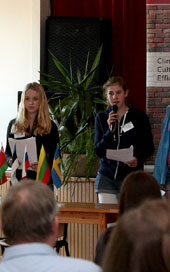01.06.2011-04.06.2011
International Youth Conference in Kothla-Järve
From 1st June 2011 until 4th of June 41 pupils from Sweden, Russia, Belarus, Estonia, Lithuania, and Germany took part in the International Youth Conference on “Climate Change, Cultural Heritage and Energy Efficient Monuments” in Kothle-Järve, Estonia.
All in all over 80 persons participated in the conference. On the first conference day the pupils presented their interpretation of the topic of the conference which showed the wide range if problems that are seen and at the same time a broad spectrum of solutions suggested. It became clear that the pupils invested a lot of time and effort in order to give a deep insight into the cultural heritage of their towns and what they want and can do to protect both, the climate and the monuments. Following to the presentation the pupils split up into five sub-groups and discussed three questions:
• What was the main message of your presentation?
• What are the main commonalities of the presentation?
• What are the main differences of the presentations?
The Result of the group discussions led to the following Declaration of the Kothla-Järve Youth Conference:
“The cultural heritage of all countries has to be preserved as well as the environment.
Pupils should be given the opportunity to both acquire knowledge about the importance of cultural heritage monuments as well as to become actively involved in the selection of those objects to be preserved.
Protection of the environment from climate change creates positive effects on cultural heritage monuments. This includes all measures to reduce CO2 as well as the reduction of harmful substances and noise that are damaging to residential amenity.
In inner city areas, travel by private cars should be reduced, use of public transport increased and networks of bicycle paths extended. Non-renewable fossil fuels have to be replaced by renewable energies.
Climate protection includes a wide variety of measures to save energy and reduce CO2 production. Historic buildings should not be excluded from this task, but at the same time corrective measures must not compromise their aesthetic qualities.
This refers especially to the insulation of walls.
School is an ideal place to learn about energy efficiency.“
On the second day the conference participants visited four cultural heritage buildings, the Mäetaguse Manor, the Kukruse Manor, Saka Manor and the Pyhtítsa Dormítion Convent where examples of the combination of renovation of the monuments and protection of climate without effecting the monument could be seen, e.g. the use of a ground heating system and a heat group in the cellar for heating the Kukruse Manor.
The cultural highlight was the presentation of cultural heritage by the pupils showing sketches and traditional dances in the traditional dresses during a concert in the Kohtla-Järve Center of Culture.

- (Source: Kohtla-Järve Town Council / Igor Parv)


